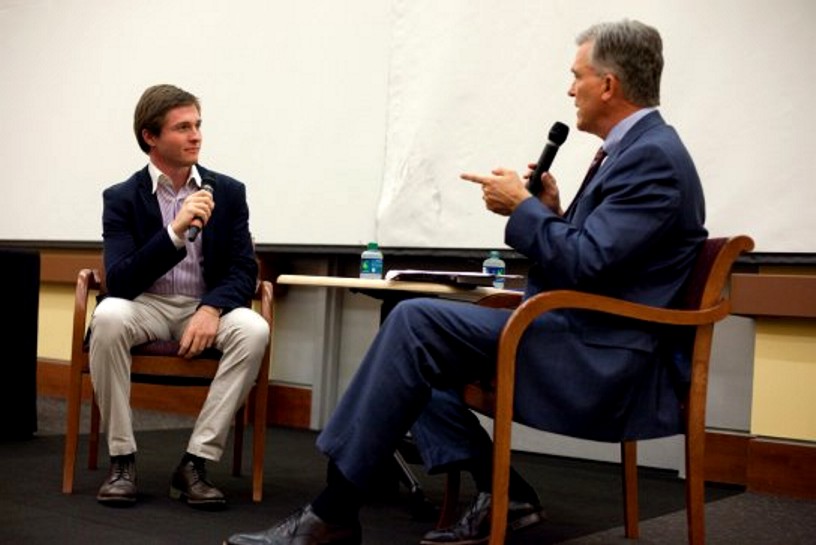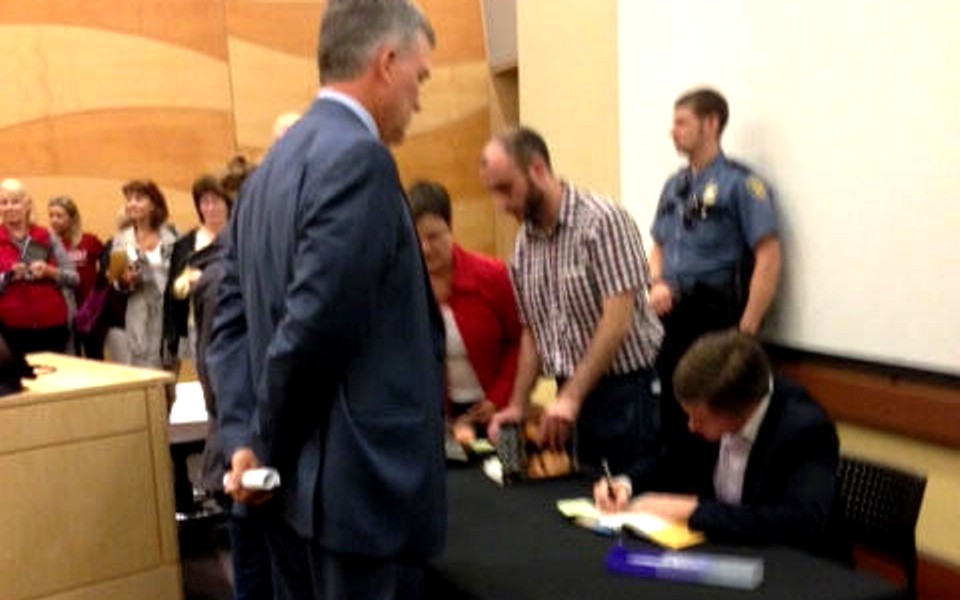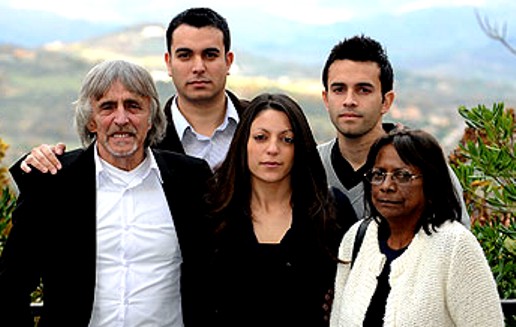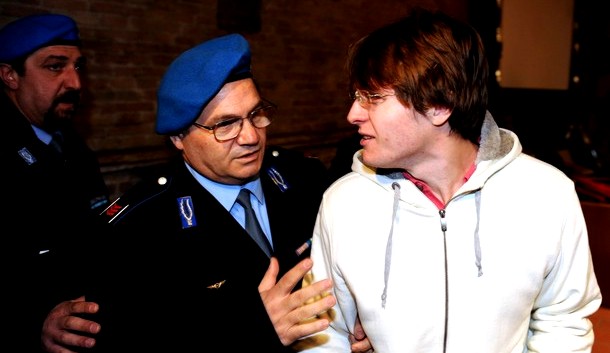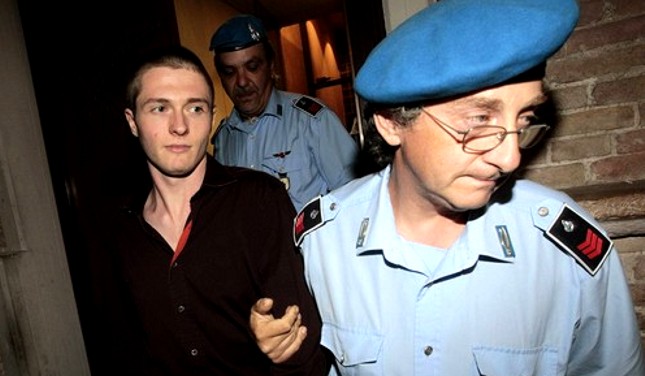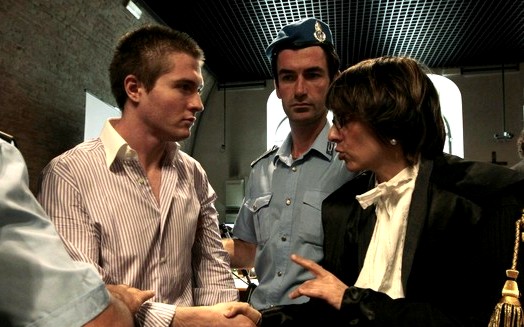
Headsup: Disney's Hulu - mafia tool?! First warning already sent to the Knox series production team about the hoaxes and mafia connections. The Daily Beast's badly duped Grace Harrington calls it "the true story of Knox’s wrongful conviction of the murder of her roommate". Harrington should google "rocco sollecito" for why Italians hesitate to talk freely.
Thursday, September 27, 2012
Sollecito’s Book Honor Bound Hits Italy And Already Scathing Reactions And Legal Trouble
Posted by Peter Quennell
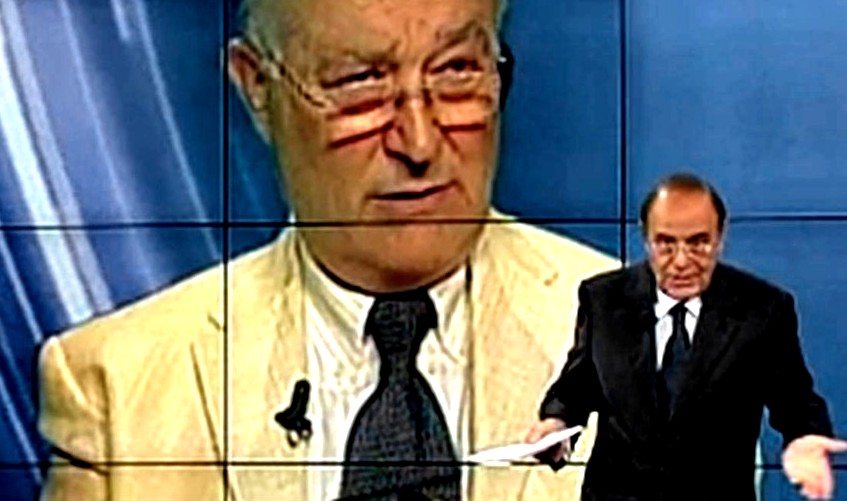
[Above: Sollecito’s father Francesco on Italian national TV being made to admit the book lied]
The Sollecito/Gumbel book is an “own goal”
In Italy the extremely inaccurate and hyper-aggressive book has already set themselves up for two kinds of trouble
The Gumbel and Sollecito book was released in English on 18 September 2012 and within ten days all of Italy knew that the book was a crock.
Sollecito’s own father and own lawyers Bongiorno and Maori have already been forced to admit the book contains serious lies.
Already the prosecution has indicated that they are weighing whether there might be new charges lodged against Sollecito.
Analysis Of 3 Claims Of Criminal Conduct
We focus on three claims by Sollecito and Gumbel of criminal behavior which have already been widely repudiated by the Italian press.
1. A deal was sought by prosecution to frame Knox
Sollecito’s own father Francesco was made to concede by the host and all other guests on the popular Porta a Porta TV show last week that Sollecito lied in claiming that the prosecution had sought a deal under which Sollecito would frame Amanda.
Such a deal would be illegal so Sollecito was falsely accusing prosecutors of a very serious crime. Francesco Sollecito backed down even more in some interviews later. One of Sollecito’s own lawyers, Luca Maori, immediately denied in obvious frustration that the offer of any deal either way ever happened, and Giulia Bongiorno soon publicly agreed. .
2. A long brutal interrogation on 5-6 November 2007
Sollecito has suddenly claimed in the book, nearly five years after he said it happened, in face of vast evidence including his own writings to the contrary, that police interrogated him over 10 hours, and abused and threatened him.
But he was demonstrably not ever interrogated over 10 hours, and he folded fast when they showed him his phone records, which contradicted his earlier alibis, and so he promptly laid the blame on Amanda.
The English translations of the lengthy court transcripts of those many who were present at the central police station on the night all coincide, and damn the version cooked up by Sollecito and Gumbel..
3. Deliberately wrong reasoning in the Galati appeal
All this trouble flows from half a dozen pages of Sollecito’s book made public in Italy! Here now are several more pages not yet known about there (we will have many more) which our poster ZiaK has translated into Italian to help everybody to read. Sollecito ridicules both Dr Galati and his appeal. Let’s see:
- Dr Galati is recognised as one of the most brilliant lawyers in Italy, and he is a former Deputy Chief Prosecutor at the Supreme Court, specially assigned to Perugia because cases involving the central government are handled there when they are too hot to handle in Rome.
- Solllecito is of course a 28-year old student with a cocaine record and a long history of parental supervision who has never held a job in his life. He failed the entrance exam in virtual reality for the University of Verona but still has delusions of a career in computer games.
And surely Gumbel would never have got the job if Bongiorno and Maori had the opportunity to size up how wildly incompetent about the law and the case and and twisted in his mind about Italy he seems to be.
These ill-advised pages below show Sollecito’s and Gumbel’s profound ignorance of Italian jurisprudence, a total incomprehension of the wide scope of the appeal, and their contempt toward the advice from his lawyers.
Passages highlighted are wrong on the hard facts as shown in part 2 below.
1. What The Sollecito/Gumbel book claims
Judge Hellmann’s sentencing report was magnificent: 143 pages of close argument that knocked down every piece of evidence against us and sided with our experts on just about every technical issue. It lambasted both the prosecution and the lower court for relying on conjecture and subjective notions of probability instead of solid evidence. And it launched a particularly harsh attack on Mignini for casting aspersions on the very concept of proof beyond a reasonable doubt.
Mignini had dismissed it in one of his court presentations as a self-defining piece of linguistic trickery. Hellmann pointed out that reasonable doubt was now””belatedly””part of the Italian criminal code. A case built on probability alone, he said, was not sufficient and must necessarily lead to the acquittal of the defendant or defendants.
The prosecution’s rebuttal of the sentencing report, filed a couple of months later, was little short of astonishing.
It accused Hellmann of indulging in circular arguments, the old rhetorical fallacy known to the ancients as petitio principii””essentially, starting with the desired conclusion and working backward. The criticism applied much more accurately to what the prosecution and Judge Massei had done themselves; everything, even the absence of evidence, had been a pretext for them to argue for our guilt. But the author of the prosecution document, Giovanni Galati, chose not to dwell on such ironies. Instead, he attacked Hellmann””I wish I were joking about this””for resorting to deductive reasoning. Making yet more allusions to grand rhetorical principles, Galati said he had a problem with the appeals court taking the available evidence and seeking to make each piece follow on logically from the last. I take it he is not a fan of Sherlock Holmes.
Galati seemed incensed that Hellmann had found the “superwitnesses” unreliable. He argued that Hellmann’s problem with Antonio Curatolo, the heroin addict in Piazza Grimana, was not his failure to be consistent about the details of when and where he had supposedly seen us but rather Hellmann’s own “unwarranted prejudice against the witness’s lifestyle.” Galati even dared to embrace Curatolo’s argument that heroin is not a hallucinogen to insist he must have been telling the truth.
These arguments, to me, made a mockery of civilized discourse. I don’t honestly know how else to characterize them.
From my experience, I also know they are the bread and butter of the Italian legal system, the peculiar language in which arguments and counterarguments are formed every day. Not only do innocents go to prison with shocking regularity, while guilty people, equally often, win reprieve or acquittal; magistrates and judges who make the most howling errors rarely pay for their mistakes.
See Part 3 below for an Italian translation of the above, kindly supplied by main poster ZiaK.
2. Correctly explaining Cassation’s reasoning
Read all the posts here. Also read all the posts linked to here.
Italy’s excellent justice system is in fact exceptionally pro defendant, and prosecutors have to jump through more hoops than any other system in the world. Major errors and framings of innocent parties never make it through to a final guilty verdict.
Correctly understood in light of that system, there was nothing magnificent about the Hellman-Zanetti outcome. The Hellmann court is KNOWN to have been hijacked.
And these posts by Cardiol and James Raper show the report was written by two biased and wrongly qualified judges way out of their depth on both the evidence and the law.
Here is main poster Machiavelli’s explanation of what Sollecito.doesn’t get. The required logic Sollecito is ridiculing is intrinsic to Italian jursprudence (and US and UK jurisprudence) and is REQUIRED by the Supreme Court.
In plain English, Dr Galati is saying that Hellmann-Zanetti ignored that requirement.
Instead, they illegally went cherrypicking, with an extreme pro-defendant bias up-front. Bold text here is to emphasize that.
2. The failure to apply the inferential-inductive method to assess circumstantial evidence. This is a key point based on jurisprudence and is in fact a devastating general argument against Hellmann-Zanetti:
The appeal to Cassation’s jurisprudence on the circumstantial case originates from the fact that the Assize Appeal Court did not deploy a unified appreciation of the circumstantial evidence and did not examine the various circumstantial items in a global and unified way.
With its judgment it has, instead, fragmented the circumstantial evidence; it has weighed each item in isolation with an erroneous logico-judicial method of proceeding, with the aim of criticizing the individual qualitative status of each of them ..
Dr Galati accuses the appeal court of focusing on the quality of some pieces of circumstantial evidence, instead of their correlation to each other as the Supreme Court always requires. .The appeal judges, in actual fact, deny that the probative reasoning and the decisive and cognitive proceeding of the court is to be found in the circumstantial evidence paradigm of the hypothetico-probabilistic kind, in which the maxims of experience, statistical probability and logical probability have a significant weight.
The court must reach a decision by means of the “inductive-inferential” method: it proceeds, by inference, from individual and certain items of data, through a series of progressive causalities, to further and fuller information, so arriving at a unification of them in the context of [13] the reconstructed hypothesis of the fact.
This means that the data, informed and justified by the conclusions, are not contained in their entirety in the premises of the reasoning, as would have happened if the reasoning were of the deductive type “¦ (..) A single element, therefore, concerning a segment of the facts, has a meaning that is not necessarily unambiguous.
Dr Galati cites and explains further:
The Perugia Court of Appeal has opted, instead, precisely for the parceled-out evaluation of individual probative elements, as if each [14] one of them must have an absolutely unambiguous meaning, and as if the reasoning to be followed were of the deductive type.
This error emerges from the text of the judgment itself, but the gravity of the error committed by the Court in its decision derives from the fact that even the individual elements had been acquired by the cognitive-decisioning process in a totally partial manner, isolating the sole aspect that allowed the recognizing of doubts and uncertainties in the element itself..
So Galati-Costagliola concludes ““ and this by now is obvious ““ that the Hellmann-Zanetti court followed a “deductive only” paradigm on pieces in isolation, instead of the “inferential-inductive” paradigm prescribed by Supreme Court requirements (1995).
Moreover, Hellmann-Zanetti applied a deductive paradigm of assessment only to some cherry picked aspects of the single isolated pieces of evidence, overlooking other qualities of the single piece (an example ““ my own ““ is the possible “contamination” of the bra clasp found on the floor in the murder room.) Ordering an assessment of the quality of any element as if it was a proof in isolation from the rest of the evidence is itself unlawful.
But Hellmann”“Zanetti also picked out of the evidence one aspect alone, for example it points to the theoretical possibility of contamination by touching from gloves, but does not consider the negative check results from the possible contamination sources. The interpretation of X-DNA from the bra-clasp by Vecchiotti in the conclusion is worded as if to ignore the results on the Y-haplotype, and so on.
So even single aspects/qualities of isolated items are further isolated from other aspects by Hellmann-Zanetti, and are assessed without looking for a relationship to the context. This is a core violation of the basics of jurisprudence in cases based on circumstantial evidence.
3. Italian Version of the passage on the Cassation appeal from Sollecito’s book
This translation is kindly provided by main poster ZiaK.
Il rapporto di motivazioni del giudice Hellmann fu magnifico: 143 pagine di ragionamenti serrati che demolirono ogni singolo pezzo di prova contro di noi, e che con riferimento a quasi ogni questione tecnica presero le parti dei nostri esperti. Il rapporto strigliò sia la pubblica accusa, sia la corte di prima istanza per il loro affidamento ai congetture e ai nozioni soggettivi di probabilità invece di dipendere su prove solide. Perdipiù, il rapporto sferrò un attaco particolarmente severo su Mignini per aver denigrato il concetto stesso di prova oltre ogni ragionevole dubbio. Mignini aveva già scartato questo concetto come un inganno linguistico auto-determinante nel corso di uno delle suoi presentazioni alla corte. Hellmann fece notare che il dubbio ragionevole fa ormai - tardivamente - parte del codice penale italiano. Una causa stabilita unicament su probabilità , disse Hellmann, non é sufficiente e deve necessariamente condurre all’assoluzione del imputato o degli imputati.
La confutazione del rapporto della parte dell’accusa, presentato in appello un paio di mese dopo, fu quasi una cosa sbalorditiva.
Accusò Hellmann di abbandonarsi a argomentazioni viziosi, in quella vecchia falsità retorica conosciuta dagli antichi come petitio principii - cioè,sostanzialmente, partire dalla conclusione desiderata per poi andare a ritroso. Questa critica potrebbe essere applicata con molto più precisione a ciò che fecero l’accusa e il giudice Massei stessi: tutto - compresa anche la mancanza di prove - gli é servito di pretesto per dare appiglio agli loro argumenti sostenendo la nostra colpevolezza. Ma l’autore di quel rapporto della pubblica accusa, Giovanni Galati, scelse di non soffermarsi su queste ironie. Al contrario, preferii attacare Hellmann - io desideri davvero fossi solo scherzando su questo punto - per il suo aver ricorso al ragionamento deduttivo. Perdipiù, facendo ancora altre allusioni a grandi principi retorici, Galati si dichiarò insoddisfatto del fatto che la Corte d’appello avesse preso prove disponibili e avesse cercato di far seguire in modo logico un pezzo dopo l’altro. Devo supporre che Galati non sia un tifoso di Sherlock Holmes.
Galati sembrò furibondo che Hellmann avesse trovato inaffidabili gli “supertestimoni”. Sostenne che la difficoltà che Hellman terrò a proposito di Antonio Curatolo, il tossicomane della Piazza Grimana, non fu la sua incapacità di ricordarsi con coerenza i dettagli su quando e dove fossimo presumibilmente visti, ma piuttosto il “pregiudizio ingiustificato contro il modo di vivere del testimone” mantenuto del stesso Hellmann. Galati osò persino cogliere l’argomento di Curatolo, secondo il quale l’eroina non é un allucinogeno, per sostenere che Curatolo avesse dovuto dire la verità .
Tali argomentazioni, al mio parere, svuotino il discorso progredìto di tutte le sue valori. In onestà , non saprei descriverli in modo diverso. Nella mia esperienza, so anche che sono il fondamento del sistema giuridico italiano, e della la lingua particolare nella quale gli argumenti e controargumentazioni sono formulati ogni giorno. Non solo gli innocenti vengono incarcerati con preoccupante frequenza, mentre le persone colpevoli con altrettanto frequenza ottengono sospensione o assoluzione, ma anche i magistrati ed i giudici che fanno gli più strepitosi errori pagano raramente per i loro sbagli.
.
[Below: Sollecito’s lead lawyer Bongiorno. Still in shock? She has made no statement yet on his book]
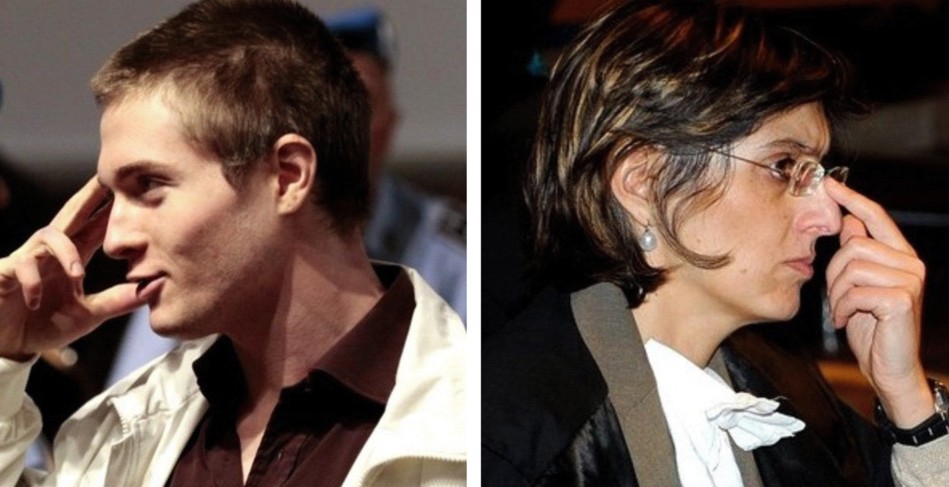
Wednesday, September 26, 2012
Kane Hall Book Promotion: Interviewer And Sollecito Panderer Dennis Bounds Drops The Ball Terribly
Posted by Media Watcher
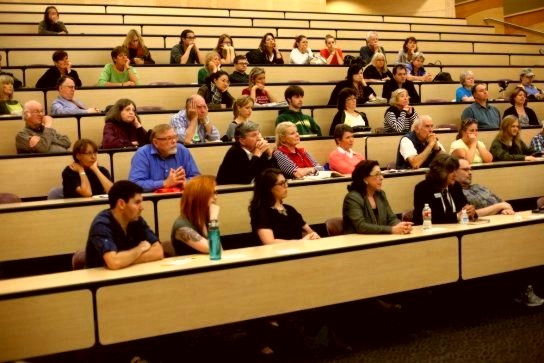
[Above: Amanda Knox’s mother and sister are to the right in the back row in white and red sweaters]
Sales statistics show that Sollecito’s book is selling terribly and light-years from recouping costs.
Tonight’s public interview showed one good reason why. A small mostly elderly entirely white crowd in Kane Hall heard Sollecito being allowed to blame it solely on the black guy. Not even his own lawyers did that. But there was no argument from the interviewer, no tension, no excitement, no sense of discovery or truth.
And the feeble questions moved on.
Dennis Bounds, anchor for KING-5 television news in Seattle, certainly demonstrated why he’s no journalist. After tossing softball after softball at Sollecito during an “interview” at UW’s Kane Hall and then teasing Sollecito that he should come to the UW as an exchange student, Bounds declared “You’re out of jail and you’re not guilty - which is the important thing.”
Untrue. Sollecito still stands accused of Meredith’s murder until the Supreme Court signs off on the case. The pandering Dennis Bounds was eagerly first in line to get a book signed by the accused. See the image at bottom.
The problem with most of the US media is that they’ve never taken the time to review the case, including the original Massei sentencing report (which gives very thoughtful, not sensational, overview of the evidence and how it ties together), what was reviewed during the appeal and what specific elements should have been under review, and what that means for the prosecutor’s appeal that’s now been submitted to Italy’s Supreme Court.
Hard questions a real journalist could have asked
These are examples of what Dennis Bounds could have asked Sollecito in direct follow-up to answers that Sollecito gave tonight, instead of moving on to the next softball.
Sollecito: After ten hours of questioning in a very rude, aggressive way”¦(one of the detectives said) “If you stand up now, I will leave you in a pool of blood.”
Journalist: Are you asserting that one of the detectives threatened you? Did you relay this to your family and ultimately to your attorneys?
Sollecito: No one ever asked me to be on the witness stand. No one ever asked me anything. I was a shadow.
Journalist: Who prevented you from testifying? Did you want to testify? Did you ask your attorneys to let you testify? Given that you were willing to testify, what can you say here tonight about why you gave so many versions of what you were doing the night the murder took place.
Sollecito: For any kind of detail, I’m here; you can ask me.
Journalist: Why did you tell detectives that there was a burglary, but nothing was taken before the room in question was even checked out? And given that it wasn’t your room, how did you know that nothing was taken?
Journalist: You and Amanda claimed that you needed to get a mop from Amanda’s flat to wipe up under a leaky sink. Why would you wait hours to go get a mop unstead of just sopping up the water with towels from your own flat?
Sollecito: Most of the people who are “guilters” follow the media and don’t know anything about the case.
Journalist: If that’s the case, why are they asking questions about how Meredith’s fresh blood got mixed with Amanda’s DNA in multiple places in the bathroom, and why are they so focused on phone records that showed that what you told detectives originally was untrue.
Sollecito: (About Rudy Guede) - He is a burglar who did similar burglaries”¦..he’s most probably implicated; he’s most probably the only one.
Journalist: If Guede was the only person there that night, where did the other footprints come from, how did Amanda’s DNA get mixed with Meredith’s blood, and who do you think staged the break-in, after making sure Meredith’s room was locked?
Journalist: And by the way, can you explain why Amanda Knox called her mother in the middle of the night, Seattle time, given that to that point, she should not have known anything about the dark events that had taken place in the flat? Were you with her when she made that call?
Tuesday, September 25, 2012
Will Sollecito Drop Amanda Knox In It Further In A Public Seattle Interview At 7:00 PM Tonight?
Posted by Peter Quennell
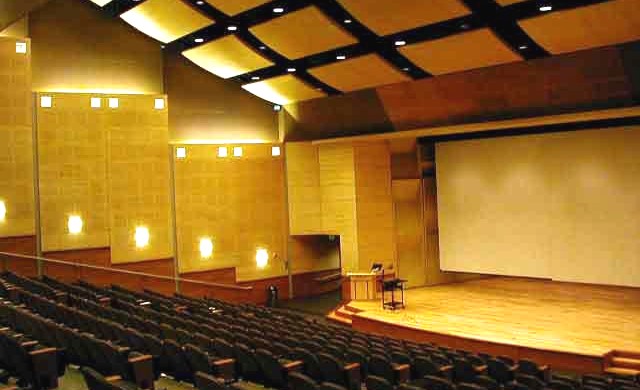
This is Kane Hall on the University of Washington campus where at 7:00 tonight Sollecito is set to be interviewed.
What was described in this excellent series by an Italian lawyer on four of the Porta a Porta shows continues to be the case. One perp slyly pushing another toward the fire, in an attempt to protect his own sorry ass.
On two levels the woolly-brained component of the Seattle media and the woolly-brained Knox-Mellas camp seem to have only the dimmest comprehension of the slow-motion train-wreck Sollecito has managed to create.
(1) Sollecito may continue to claim that he “saved” Amanda by standing by her when others urged not to, but as future posts here will show, he provably didnt, and in his book in a number of places he includes very incriminatory points about her.
(2) Provable lies in Sollecito’s book have already stirred up a hornet’s nest in Italy and his own father and his lawyers have backed off - right when RS and AK face one of the toughest appeals our Italian lawyers have ever seen.
Can Sollecito be expected to make things worse both for Amanda and for himself tonight? It may not be obvious to much of the audience, but our own bet is: for sure. Must-read posts in advance here and here and here.
And a must-read book. That narcissistic killer flaunted the system - and is now doing 33 years.
Friday, September 21, 2012
The Rather Strained Couric-Sollecito Interview: Reading Between The Lines (2)
Posted by James Higham
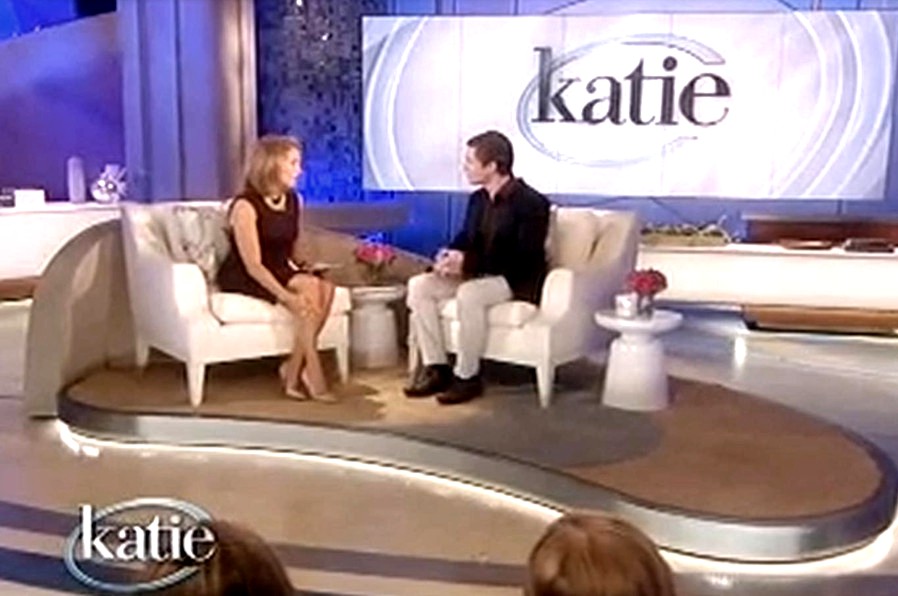
Katie Couric interviewed Sollecito, more briefly and frostily than expected, last Tuesday afternoon in New York. You can read the transcript here.
Sicily based blogger Welshcakes Limoncello commented on a summary of the interview I posted on my own website. “Do you think we will ever know the truth?”
It was a neutral statement, one so many must have made around the world when they considered the case in as much detail as the media allowed. The short answer, for those who’ve gone into the evidence in as much detail as PMF, TJMK and dozens of others, including me have, is a resounding: “Yes, we do actually. We are as sure as any court needs to be or has ever been, short of a signed confession.”
This is not an even playing field in the least. The evidence points one way, the professionals in the field concur, the Kercher family who, one needs to remember, were neutrals in the sense of whoever emerged as the killers they’d be down on, have sat through every bit of evidence as it was presented and they concur. Nineteen justices who reviewed the case concurred.
One can’t just sweep that under the carpet, claiming there was “zero evidence”, not when that time and effort when into gathering and considering it all, not when consideration of the evidence presented filled hundreds of pages. Just what are people trying to pull, claiming there was “zero evidence”?
And the defence ““ it hasn’t chosen to attack pieces of evidence [around 130 pieces of it] which they know they can’t attack. They picked on two main pieces in the appeal and failed to establish either, except in the minds of Zanetti and Hellman, the appointee who came in when the original trial judge was replaced. Would he risk his reputation and hundreds of pages of scathing consideration of Hellman and Zanetti if there was zero in it in the first place?
I mean, at what point doe blind denial cease and the cumulative weight of evidence win the day? Not cherrypicking two pieces of evidence and the judges refusing to hear the rest. I mean cumulatively ““ all of it.
And cumulatively is the only way to approach this case ““ what the totality of evidence, not the cherrypicking, points to. The weight of that evidence, from the DNA to the false alibis and the phone calls, would be sufficient to put anyone away, let alone the Supreme Court view that there was most certainly more than one killer, a point Sollecito, in his Couric interview, does not pooh-pooh. Wasn’t that interesting? He hopes the Kerchers will one day find the killers.
Not only was Sollecito forgetful of what had already been given as evidence but he has shown himself an inveterate liar. When you accuse someone of being a liar, as a certain commenter at Orphans of Liberty is wont to regularly accuse me of, being asked to produce his evidence of that and then dropping into assertion and ad hominem with no evidence whatever, the outcome is not one of life and death.
In Sollecito’s case, it is ““ the death of Meredith Kercher. So, I’ve accused him of being a liar. Where is my evidence? See this post by the Machine of April 2009.
There comes a point when one wonders why most who are still supporting Knox and Sollecito are doing so. One can understand the family and close friends doing so against all the evidence but not people like that professor at John Jay University who made the same assertions, minus evidence and relied on his learned credentials to convince.
Minus evidence, minus evidence ““ it has to be repeated over and over.
[Below: a previous interviewee who was more in Katie Couric’s class]
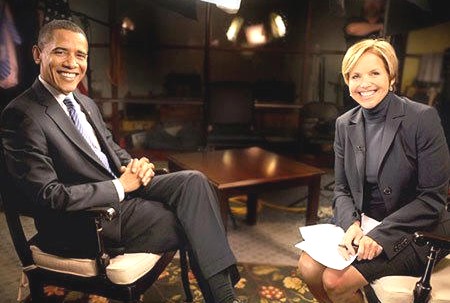
Thursday, September 20, 2012
Dr Galati: Here On American TV Tonight Raffaele Sollecito Apparently Commits Felony Defamation
Posted by Peter Quennell
Right now, Raffaele Sollecito, an Italian, is swanning around the United States with the apparent sole purpose of making his home country look bad.
As he is still accused of murder and other felonies until the Supreme Court signs off on the case, and accused felons are normally never allowed to enter the US by Immigration, it seems Sollecito could be here in the US illegally.
This video above was recorded from the Anderson Cooper news program on CNN at 8:45 pm tonight.
Here Raffaele Sollecito claims to have been abused and threatened by interrogators and claims that the same thing happened to Amanda Knox. He implies that he held out for hours, and that Knox was interrogated for 10 hours.
This seems to our lawyers precisely the same kind of invented malicious claim against interrogators which has resulted in both Amanda Knox and her parents being sued for felony defamation (calunnia) by police officers present when she was interrogated.
We know that both Sollecito’s own father Francesco AND HIS LAWYER Mr Maori have just indicated on national Italian TV that Sollecito was lying when he made this and other claims in his book. He has zero evidence to prove it, and he cannot point to anyone who abused him.
Sollecito had more than four years at trial and appeal and on national TV and privately with his lawyers to lodge such charges of abuse - and yet he never did. Not once did he ever advance them even though they might have got him off.
He did not even mention it in his nationally televised interview in Italy soon after he was released. He had to come to America to start making it - as blackmail, to make the Knox forces get him a resident visa? .
What do we believe really happened? This is from our July 2009 post on Sollecito’s many alibis.
Sollecito was asked to return to the police station on 5 November to answer some more questions. He was at that time confronted with telephone records that proved that he and Amanda Knox had lied previously.
So for his third alibi, which now cut Amanda Knox loose and implicated her, Sollecito claimed that he was at his apartment all evening, and that for part of the evening Knox was out, from 9 pm to 1 am.
In my previous statement I told a load of rubbish because Amanda had convinced me of her version of the facts and I didn’t think about the inconsistencies…..
Amanda and I went into town at around 6pm, but I don’t remember what we did. We stayed there until around 8.30 or 9pm.
At 9pm I went home alone and Amanda said that she was going to Le Chic because she wanted to meet some friends. We said goodbye. I went home, I rolled myself a spliff and made some dinner.”
He goes on to say that Amanda returned to his house at around 1am and the couple went to bed, although he couldn’t remember if they had sex.
How did things proceed from there? Did Sollecto or his lawyers claim that he had been tricked or abused into a “confession” ? No…
This third alibi was undercut by Amanda Knox when she took the stand and testified. She stated that she was with Sollecito at his place all night.
It was also contradicted by the forensic evidence presented by the prosecution: the four separate pieces of forensic evidence that placed him in the cottage on Via Della Pergola on the night of the murder.
This third alibi was also undermined by the telephone records and by the data taken from his computer.
Sollecito claimed that he had spoken to his father at 11 pm. The phone records showed that to the contrary, there was no telephone conversation at this time, though Sollecito’s father had called him a couple of hours earlier, at 8.40 pm.
Sollecito claimed that he was surfing the internet from 11 pm to 1 am. Marco Trotta, a police computer expert, testified that the last human interaction on Sollecito’s computer that evening was at 9.10 pm and the next human activity on Sollecito’s computer was at 5.32 am.
Sollecito said that he downloaded and watched the film Amelie during the night. However, Mr Trotta said that the film had been watched at around 6.30 pm, and it was earlier testified that Meredith returned to the cottage she shared with Amanda Knox at about 9 pm.
Sollecito claimed that he had slept in until 10 am the next day. There was expert prosecution testimony that his mobile phone was actually turned on at 6.02 am. The Italian Supreme Court remarked that his night must have been “sleepless” to say the least.
This alibi was undermined by the eyewitness Antonio Curatolo, the watcher in the park above the house, who testified that he saw Sollecito there.
From 2007 to 2011 Solleceto was rather notorious for NOT reaching out to Amanda Knox during trial and appeal and for NOT fully supporting her alibi. He has never retracted the statement that she was absent from his house from 9:00 pm to 1:00 am on the night Meredith was murdered.
This may be giving the Knox-Mellases some grins. They despise Sollecito, and they know full well of his treachery toward Amanda during trial when his own lawyer Bongiorno repeatedly blamed Knox (scroll down). They are presumably appalled at his loose lips and dishonest book which mess with her own prospects. .
the book’s title is a living lie. There is nothing honorable about him. And he is acting treacherously and cowardly toward his own country.
Wednesday, September 19, 2012
The Rather Strained Couric-Sollecito Interview: Reading Between The Lines (1)
Posted by Hopeful

Raffaele’s physical appearance was okay. He was groomed and dressed well. I alternately felt sorry for him and grossed out by him when I sensed he was lying from a cunning script.
He has taken a page out of Amanda’s playbook by using English instead of his native Italian with a translator, so the audience will identify with him and so he can buy time to formulate safe answers. He wants to show off to Amanda that he is as quick to master language as she is.
Katie Couric definitely put him on the defensive. Her maturity and restraint honed over years of interviews gave her the advantage. It must be so hard to smile and remain polite when you harbor suspicions you’re talking to a liar and stonecold killer. Her civility and training stood her in good stead.
She didn’t reveal too much disgust, but some slipped out. She did poke and prod for hard truth as much as possible within the limited format.
I think the biggest clue to Raffaele’s dishonesty was his refusal to denounce Meredith’s “real” killer, Rudy Guede. Had he not been part of the violence or obstruction of justice against Meredith, he would have the moral high ground to express natural horror rage and resentment against this “real” killer, a killer whose act has also destroyed Sollecito’s life.
If he were totally innocent, Raffaele would want only to name and shame Guede and howl for the harshest punishment. If Guede had gotten me involved in such a nightmare I would blame him without regret and with no game-playing or fear of his lies. The fact that Raf does not dare to anger Guede and refuses to judge the known killer who has dropped Raf into a living hell is a sign of some perverse obligation to Guede, fear of Guede, or guilty knowledge or some unnatural response.
He refuses to denounce Guede, while he revels in his coverup for Amanda. This suggests he is part of the crime. He denounces prison loudly enough! He seemed to want to say that prison serves absolutely no purpose at all, incarceration accomplishes nothing. This is simply a reflection of how much he hated prison, not how little he deserved it.
His big glory seems to be bucking his family, and rejecting their good advice, while professing to understand they are blinded by love and concern for him.
His tone is condescending. No, he will spare his family nothing. He prefers to turn his back on their best interests (which would be to have a son who could earn a solid living and eventually help his father in old age or sister, has Raf ever thought of success as a gift he can give them? No, it seems he wants drama and destruction and waste).
While his book claims Dr. and Sister Sollecito were begging him to reveal the truth regardless of whether it hurt Amanda or not, he turns his back on them and on truth completely. His desire is to honor a wildcat female who used him and cost his father and sister everything.
What a mockery of real honor. He’s ready to save Amanda a prison sentence no matter how big a liar he must become or how much terror he brings to his family or expense and stress on them. His childish and mistaken attitude was that Amanda loves him, Amanda is all that matters.
Thus he becomes a foolish and destructive ennabler, saving Amanda from the natural results of her own bad acts that would finally teach her something real. He wants to rescue her and his vanity since she reflects his romantic choice and he doesn’t want that criticized.
He will rescue her at cost of destroying the family who has truly loved him and stood by him, even though he has so many unresolved issues with them. I think this is because he has not felt strong enough to stand up to his family in the normal teenage years of establishing boundaries, usually through mild rebellion.
His fear of losing his father since he was motherless, or their overbearing powerful personalities (doctor and policeman) left his growth undone at the normal time. He is still a child. But his role in this crime has become a way out for him.
Raf is in hog heaven. He can emigrate from Italy to the U.S. for survival reasons that his folks must understand, since they assure him they don’t want him in prison. This is his way to get others to boot him to where he wanted to go all along. (Munich wasn’t far enough, and he was soon back home dejected.)
His biggest joy seems to be deceiving the police. His sister’s biggest mistake was doing shady stuff to help this ingrate brother, and his father will learn the same lesson.
It’s really sad because Dr. Francesco Sollecito Senior deserves better than this from his only son. Raf wants to lower the bar on their expectations of him. In that he has succeeded. His main goal is to disappoint his father and compromise his sister since he cannot compete with their workplace achievements and no longer has a mother to protect.
Raffaele took another page from Amanda by giving a lengthy and ambiguous answer to the question, “What would you say to people who still think you are guilty?” He never gets around to categorically denying he killed Meredith! Instead he harps on the media having deceived the public.
Of course the fog of nonsense is his own and Amanda’s.
Tuesday, September 18, 2012
Questions For Sollecito: Katie Couric, Push Back Against Sollecito’s Bluster And False Facts #2
Posted by Our Main Posters
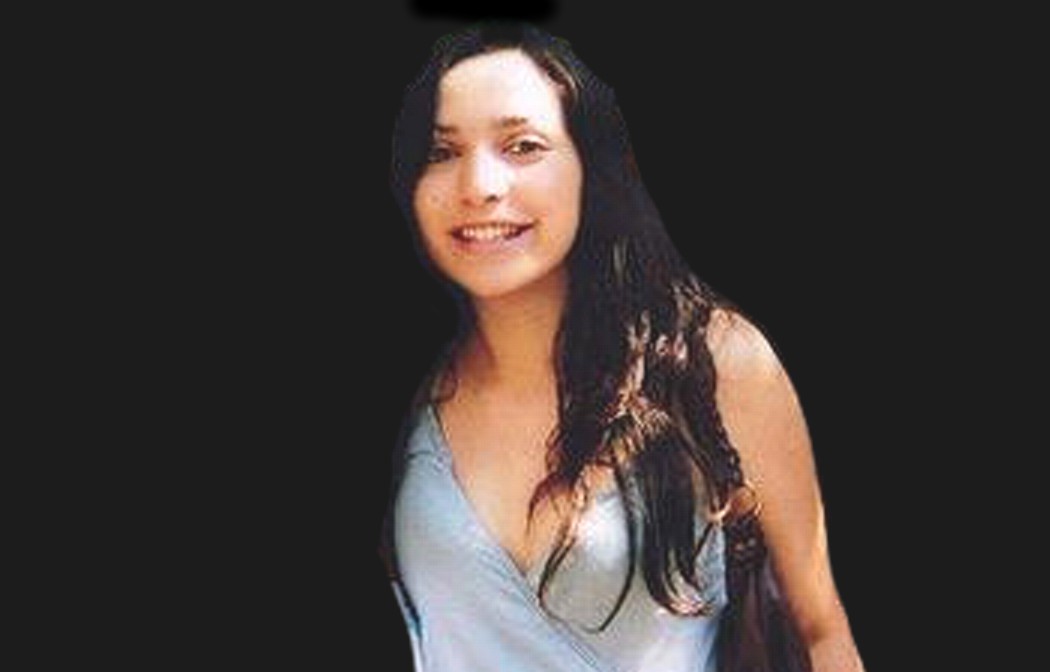
[The vastly more talented person, Meredith, who the smug and odious Sollecito still stands accused of killing]
Kermit has suggested some very tough questions in the Powerpoints post directly below.
Here are ten more of the possible dozens of unanswered questions that Katie Couric and other media interviewers of Sollecito should ask him, and we invite readers to suggest more questions in Comments below.
II should be recalled that all three suspects were brought to trial on the same body of evidence. Judges at Guede’s trial court, his first appeal court, and the Supreme Court of Cassation have all ruled that the evidence showed that it was impossible for him to have attacked Meredith alone.
Despite contradictory efforts by the defenses in the Sollecito and Knox appeal to make credible two possible sets of alternative killers, both attempts descended into courtroom farce. Right now, all of the considerable body of evidence still points ONLY at the three originally charged.
Several context points from the previous post below with this same title should be reiterated here.
1) Sollecito was NOT finally acquitted at the end of 2011; as all the media have been wrongly parroting. He still stands accused until the appeal process fully plays out - and in some similar cases, that has taken years. As he is still accused of a murder and other felonies he might be in the United States illegally.
2) The investigation and crime-scene analysis resulted in a very powerful case at trial, the trial judges’ reasoning was brilliant and precise, and they showed NO media influence, NO satanic theory, NO desperate prosecutor, NO rush to judgment, and NO hint that it had all been inspired by Knox’s and Sollecito’s quirky behavior, or by a misinterpretation of the effect of drugs.
3) Knox and Sollecito were convicted at trial based on clashing alibis, autopsy evidence, blood evidence, footprint evidence, cellphone evidence, computer-use evidence, eye-witness evidence, and so on and on. In the UK and US any ONE item might have been enough. They both refused to be fully cross examined at trial. Knox was only partly examined, about her false charge of murder against Patrick Lumumba, but even so she did herself harm.
4) A bizarre and suspect last-minute change of appeal judges resulted in a bizarre and suspect court management, a bizarre and suspect DNA consultancy, a bizarre and suspect appeal verdict, and a bizarre and suspect appeal sentencing report - which in enormous detail has been dissected by the Chief Prosecutor of Umbria, Dr Galati, in an appeal to the Supreme Court and shown to have broken Italian law in a large number of respects.
5) The entire officialdom of Perugia holds a pro-guilt view. Dr Galati holds this view. Relevant officials in Rome all hold this view. Probably 95 percent of the interested Italian population hold this view. The vast majority of Italian journalists hold this view. The Rome-based foreign reporters all hold this view. A large if unknown fraction in the UK and US populations hold this view. Behind the scenes in the NYC media, a majority seem to hold this view. Hillary Clinton and the ambassador in Rome hold this view. Knox’s and Sollecito’s lawyers at trial in 2009 seemed less than firm believers in their innocence. Both families have acted as if they KNEW there was guilty involvement all along.
While Sollecito did not take the stand during the trial or the appeal, he did make a number of voluntary written statements entitled “Notes on a Prison Journey” which were edited and given to the media by his lawyers. These notes have been meticulously translated into English by the PMF translators and are available here. They don’t show him in an innocent light.
With so many questions unanswered, it would be unconscionable for any good reporter or network to allow Sollecito to promote his book and case one-sidedly on their nationally-syndicated talk shows without answering some tough questions. Keeping in mind that a talk show is not the best place to debate forensic evidence and other intricacies of the case, we offer these ten example questions in other areas, which with Kermits questions below should start to get to the core of what Sollecito did and didn’t do on the night.
1. The Kercher family has asked that people involved in the case keep a low profile out of respect for their daughter Meredith. What effect do you think your loud promotion of this tendentious book deal will have on the Kerchers?
2. Did your publisher, Simon & Schuster, express any concern that you might yet be convicted of this murder, if the Supreme Court rules in March that you were improperly acquitted? And that if Italian officialdom is smeared, they may risk charges of calunnia?
3. You were the person closest to Amanda Knox in the days before the murder. Why did you write that Amanda was “detached from reality?” What in your view is her psychology? Is she loyal to you? And do you always see eye to eye?
4. You and Amanda were among the last people to see Meredith alive. Did you hear Meredith’s conversation with Amanda, if any, before she left to have dinner with friends? If so, what was said, and in what tone?
5. That afternoon you claim the two of you merely smoked a little marijuana but both suffered mental black-outs. Amazing. Medically very unusual. At what time precisely did you both stop remembering, and at what time did you both start remembering again?
6. If neither of you can remember what happened that night, how can you be so sure you and Amanda had nothing to do with the murder? How in that light do you account for highly incriminating forensic and computer and cellphone and eyewitness evidence?
7. Inconsistencies between Amanda’s account of what she found at her cottage the next morning, and what you said you saw when you got there, make the story seem made up. For example, you wrote that the first thing you noticed - you said that you remembered this particularly well - was one of the bedroom doors was wide open, the window was broken and the room was a mess. But Amanda wrote that the door was closed and the break-in wasn’t discovered until you conducted a search of the house. Why don’t your stories match?
8. Both of you have described how, after Meredith didn’t answer, you tried to kick down her bedroom door. It was easily pushed in later. Were you surprised that you were unable to break it down, despite having taken eight years of kickboxing lessons?
9. Were the police wrong to arrest you after you specifically and quite readily told them that Amanda had persuaded you to lie to them, and to say that she’d been home with you all night when you had consistently maintained that she wasn’t?
10. Rudy Guede, the man confirmed convicted by the Supreme Court of Cassation of murder and a sex crime, in complicity (“in concorso”) with two other people, says that you were the other two people there. Guede is eligible for parole later this decade. Do you think that his parole should be denied? Did the Supreme Court get it wrong? Is Guede the sole killer, and if so how?
Friday, September 14, 2012
Questions For Sollecito: Katie Couric, Push Back Against Sollecito’s Bluster And False Facts
Posted by Our Main Posters

Last Monday at 3:00 pm in the ABC TV1 studio on West 66th in New York city, Katie Couric launched a one-hour talk-show which will run five days a week. Next tuesday she will interview Raffaele Sollecito.
Who is Katie Couric?
In the fifteen years leading up to 2006, Katie Couric was a lively, bright and often very funny morning-show compere on NBC’s Today show . In 2006, she switched to CBS, to become the first woman to anchor the evening news. She also did a number of interviews for CBS’s 60 Minutes airing on Sunday nights.
In those years, she cultivated the broadest range of interview styles of anyone in American TV. Many of her interview questions are sympathetic puffballs. Her own husband died of cancer in 1998 when he was 42 and she 41, with two daughters not yet in their teens, so she relates unusually well to guests who have had tragedies in their own lives.
At other times, though, she can be as tenacious as a tiger. In 2008 she did a series of interviews with Sarah Palin, the Republican vice-presidential candidate, in which Palin looked far from ready for prime time. Palin and John McCain, the presidential candidate, lost the election to Barack Obama and Joe Biden by a substantial margin.
Some still blame Couric for asking Palin the few “gotcha” questions which stumped her, though in general it is accepted that Couric helped to show up somebody too misinformed, strident and shoot-from-the-hip to be a president-in-waiting. A recent movie version confirmed this.
So which Couric will viewers see weekdays on ABC? The puffball thrower, or the tiger? Almost certainly a bit of both, for ABC hope it is this danger and uncertainty in Couric’s interviews that will drag millions of viewers in daily.
The Sollecito interview next tuesday
For Katie Couric, this represents a good opportunity - she could really make news here - and maybe something of a risk. The risk comes only if she is briefed only by the Knox-Sollecito PR people and the book agents and book publishers that handle Sollecito.
She may leave her millions of viewers only dimly aware of Sollecito’s true legal status, and presuming that both Sollecito and Knox are off the hook, and that there is “no evidence”, and that those meanie Italians have done something really nefarious.
All of the media reports on Sollecito and Knox this past week that said “they were acquitted” have it seriously wrong.
This is merely the interval between the second act (the first appeal of 2011) and the third (the Supreme Court appeal 0f 2013) which will start playing out on 23 March. There could be several more acts to come, maybe including a complete repeat of the first appeal, which the Supreme Court has not hesitated to insist on before.
Meanwhile, Sollecito’s correct legal status under Italian law (along with that of Amanda Knox) is that he still stands accused of murdering Meredith, until the Supreme Court signs off on a verdict.
The risk for Couric is that if she does only a puffball interview, and allows herself to be snowed by the dishonest PR and in effect turned into yet another shill, she could come down on what could soon emerge as the losing side, and helped build sympathy for a killer.
We just saw the perfect example of this. A senior psychology professor at the John Jay College of Criminal Justice, less than 10 minutes walk from ABC’s west-side studios, swallowed the PR line on Knox and Sollecito without the slightest checking. You can read his sorry story here and here.
Since then, only an embarrassed silence.
This is a 20 point road-map of the Perugia case for the Couric people and any new readers that her show sends to TJMK and PMF. Post (2) will have some really tough questions, which Sollecito can be expected to flunk. With luck, these posts will turn Couric & company into tigers. Enjoy the hot seat, Sollecito.
1. Sollecito is not the real victim in this case
While Couric’s predecessor Oprah was snowed by the PR 18 months ago, she did to her credit remember Meredith, and closed with a huge photo of her that lingered. This is the real Meredith as an in-memoriam post described her.
Meredith really hit the ground running in Perugia. She had dreamed of it for a long time.
She bonded immediately with her two nice Italian flatmates, who were both working in town, and soon with the neighbors downstairs. Within days she had an “instant crowd’ of the girls from Leeds and other UK universities.
She liked the house, liked the clubs, liked walking Perugia, liked the culture and the fun festivals in Perugia. Her first encounters with her new boyfriend downstairs, an Italian musician, were said to be shy and sweet.
And she was focused and already working her tail off. She had won a well-funded Erasmus grant and although she wanted to work a little, she had no worries about money.
She arrived with an excellent command of Italian after two years of hard study at the European Studies school in Leeds, and at the Università per Stranieri she was clearly going to excel.
She was also studying politics and economics at the main university, which was very close, and she seemed set to go very far. her eyes were already on the powerful international bodies in Brussels.
2. Italy’s excellent justice system is very pro defendant
Prosecutors have to jump through more hoops than any other system in the world. Major errors and framings of innocent parties never make it through to a final guilty verdict. Please read here and here.
Proportionally Italy has only one-seventh the murder rate of the US and proportionally less than one-twentieth of the prison population of the US. Hardly a justice system out of control. .
3. Meredith’s murder was a cruel and depraved act
Although a key trial session on the barbaric 15-minute struggle with Meredith was closed to the public Italians know how cruel and depraved it was and how it HAD to have involved three attackers.
4. The case was well investigated and well prosecuted
The investigation and crime-scene analysis resulted in a very powerful case at trial as that long series of Powerpoints brilliantly summarises
The judges’ reasoning was brilliant and precise and showed NO media influence, NO satanic theory, NO desperate prosecutor, NO rush to judgment, and NO hint that it had all been inspired by Knox’s and Sollecito’s quirky callous behavior after Meredith died - that behavior by the way suggested they enjoyed toying with the police until they were finally arrested.
They were convicted based on clashing alibis, autopsy evidence, blood evidence, footprint evidence, cellphone evidence, computer-use evidence, eye-witness evidence, and so on and on. Quirky callous behavior (which did happen) was barely on the radar at trial.
5. Knox and Sollecito were never cross examined at trial
Had they been, they would almost certainly have collapsed almost instantly - as Couric hopefully will find out.
Instead, the defendants made repeated unchallenged statements to the court, as the Italian system allows, many highly self-serving, and when Knox took the stand only to explain why she fingered Patrick Lumumba, prosecution questions were highly hedged by prior agreement.
These are among the many dozens of open questions (more for Sollecito in our next post) which the defendants have still never confronted.
- Here is Kermit’s list of 150 questions which so far have never been answered by either of the formerly convicted perps.
- Here is Kermit on Sollecito’s footprint on the mat which Judge Micheli and Judge Massei accepted and Judge Hellman only weakly and possibly illegally rebutted.
- Here again is the Machine on RS’s various alibis the strange arc of which two years later is still unexplained.
- Here is lawyer SomeAlibi’s list of evidence points of a year ago which Hellman weakly rebutted or ignored and which still call for convincing explanations.
6. This was no lone wolf crime by Rudy Guede alone
After a fatuous failed attempt by a defense attorney to have a tall athletic staff member climb through Filomena’s bedroom window the defenses NEVER EVER argued that Guede acting alone could have done it.
They simply ignored the evidence of a rearranged crime scene in that bedroom and at appeal introduced TWO conflicting witnesses Mario Alessi and Luciano Aviello to try to show other people were involved. Both collapsed under examination.
7. Investigative and prosecution staff performed just fine
Curt Knox’s campaign and American media have carried out what looks to us like the real frame here, that of claiming (only in English) that the police and investigators and prosecution were corrupt or incompetent or driven by Satan.
NONE of this conspircacy theory is believed by anyone in Italy who knows about it. Police and investigators and prosecution had every chance to explain themselves (in Italian) in the court and newspapers and on TV. Read here and here and here and here.
8. The “guilty” trial outcomes convinced more than Italians
With few exceptions Italians continue to regard Sollecito and Knox as guilty. No wonder he is so desperate to get out of the place. He was never ever very popular there, and prior to Meredith’s murder he came across like a perverted loner with a drug habit who needed constant supervision by his father.
In 2008 when Sollecito was being transported to Verona University for an entrance exam in virtual reality (which he failed) he was yelled at by an angry crowd when the police van stopped at an autostrada service area for a restroom break. He was bundled back in and the police van took off in a hurry.
The entire officialdom of Perugia holds a pro-guilt view. Umbria’s chief prosecutor Dr Galati holds this view. Relevant officials in Rome all hold this view. Probably 95 percent of the interested Italian population hold this view. The vast majority of Italian journalists hold this view. The Rome-based foreign reporters all hold this view. A large if unknown fraction in the UK and US populations hold this view.
Behind the scenes in the NYC media a majority seem to hold this view. Some of the publishers who were offered the books hold this view. Hillary Clinton and the ambassador in Rome seem to hold this view. Many lawyers and even judges who read here hold this view. Even Knox’s and Sollecitos lawyers at trial in 2009 seemed less than firm believers in them.
Even some who knew Knox and Sollecito from way back in childhood in their home towns were unsurprised when they were first arrested and locked up in November 2007.
9. Both families face trials for attempted subversion of justice
While suggestive of a belief in their offsprings’ guilt rather than probative, both families are charged with attempts to subvert justice. Knox’s parents are being sued by the police interrogators who they claimed without evidence had abused her. (Mignini is not one of them, as he was not there.)
Charges against the Sollecito family (five of them) are more serious and are being brought by the Italian state. Read here and here and here.
10. A change of appeal judges may have been engineered
The highly qualified senior criminal judge in Perugia Judge Chiari was slated to preside over the appeal. He was mysteriously yanked at the last moment and reported angry, and instead two ill-qualified civil judges with questionable impartiality (they each had something to gain from a not-guilty verdict) presided over the appeal.
[Below: Katie Couric during a break in one of the 2008 interviews with Sarah Palin]

11. The appeal sentencing report’s quality is appalling
Our Italian lawyers say this is the most amateurish sentencing report in a murder case they have even seen. Please read here.
12. The independent DNA report’s quality is appalling
There a strong internal hint that the grandstanding American academic Hampikian might have been involved in its creation. Please read here.
13. The prosecution has lodged a very strong Supreme Court appeal
The chief prosecutor of the province of Umbria, Dr Galati, was himself until last year a deputy chief prosecutor at the Supreme Court in Rome. His expertise and credibility at this level outclasses that of all the other lawyers on the case combined. Please read here.
14. More trouble ahead for the families and defenses in other cases
Please read here. The key cases from the point of view of an outcome for Sollecito and Knox are the investigations into Alessi and especially Luciano Aviello who claimed that bribes were offered in his prison for testimony favorable to Sollecito.
That Judge Hellmann chose not to pursue that stunning claim, which could have thrown the appeal trial, is one of the points of Dr Galati’s appeal to the Supreme Court which if accepted could result in a new appeal trial.
It could also result in Sollecito’s lead lawyer Giulia Bongiorno (who is reputed to dislike him) having to take herself off the case.
15. Sollecito did a much derided interview in Italy
This was late last year after the appeal verdict. That much-watched one-hour interview with Sollecito seems to have totally bombed. Sollecito gave little away, and sounded smug, narcissistic, whiny, and sophomoric.
He probably convinced nobody of his innocence and reinforced the suspicions of those who are pro-guilt. He is said to come across 5 to 10 years below his real age, and that certainly is what happened here. After that one interview, other Italian networks were not exactly lining up for more of the same.
There are of course many excellent pro-guilt commentators in Italy, including Garofano, Sarzanini, Benedettelli, Giuttiari, and Castellini, Dont hold your breath hoping the little coward is ever put face to face with them.
16. No lawyers or media lawyers now publicly support RS
The probable problem is that they have actually got to grips with the translated court documents. Even Knox legal advisors Ted Simon and Robert Barnettt have long been silent. Please read here and here and here.
17. Several who did speak out for him looked like PR shills
Geraldo Rivera of Fox cable TV was one who bizarrely spoke out, and Jane Velez Mitchell of CNN Headline News was another. So was Joe Tacopina of ABC News, who also soon disappeared. So was Lis Wiehl. So was John Q Kelly.
18. Several good media lawyers speak out against him
In the USA Nancy Grace, Wendy Murphy, Jeanine Pirro, and Ann Coulter have all stated that they perceive guilt. Please read here and here and here and here.
19. Public relations hoaxes in attempt to help defendants
While suggestive of a belief in their offsprings’ guilt rather than probative, campaigns for both defendants have run under the Italian radar what amounted to hoaxes to mislead the American and British publics. Please read here and here.
Agents and ghost writers and publishers for the pro-Sollecito and pro Knox books also seem to fall into this category. Please read here and here and here and here.
20. Bigotry and xenophobia should be no part of any campaign
Huge strains of bigotry against Italians and black people and xenophobia against Italy have always been kept on the boil by Curt Knox’s defense campaign. Oprah Winfrey didnt realise, and she ended up in the absurd position of supporting probable white killers while pointing only to Rudy Guede, a black man, and smearing Italy.
Curt Knox’s hatchet men have made a considerable industry out of ridiculing the Italian police and the prosecution - but only in English. As explained here the police for the most part are the Italian equivalent of the FBI and considered among the finest in the world.
There were always several prosecutors at least on the case throughout the entire process, and they all followed the letter of the law. The impugning of Italian officials by falsely accusing them of crimes as Curt Knox’s campaign often does is itself a crime under Italian law.
Italians and Italian-Americans and Italian officials and black people everywhere deserve very much better than this. Katie Couric seems ideally suited to finally assert a balance and a return to decency, legality, and justice for the true victim, Meredith, and her loving family.
She should use this interview to nail Sollecito and hammer a stake through the PR campaign’s heart.
***
Next post: questions we recommend that Katie Couric put to Raffaele Sollecito.
Tuesday, September 11, 2012
Raffaele Sollecito’s DNA In Meredith’s Room Could Be Definitive Proof Of Guilt For New Appeal Jury
Posted by James Raper
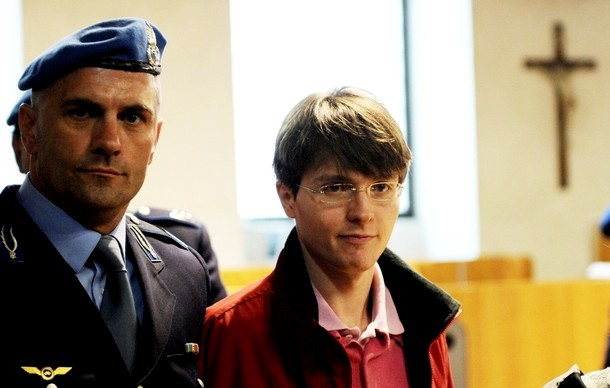
Have you followed our series on the hapless independent DNA consultants Conti and Vecchiotti? And our series on the hapless appeal judges Hellmann and Zanetti?
And our series on their formidable nemesis, Umbria’s Chief Prosecutor, Dr Galati? Who may very well convince the Supreme Court to throw out all of their work?
This post explains why their work probably deserves to be thrown out as it applies to Sollecito’s DNA in Meredith’s room, which still lacks an alternative non-damning explanation for it being there, and which could see him back serving his term in Capanne or Terni Prison before too long.
I want to start this analysis with the following verbatim quote taken from John Follain’s Death In Perugia.
“Comodi asked Vecchiotti about the alleged contamination of the bra clasp: “Is it possible for [Raffaele’s] DNA to end up only on the bra clasp?”
“Possible”, Vecchiotti said.
Comodi insisted: “Probable?”
“Probable”, Vecchiotti retorted.
Anyone who has read the Conti-Vecchiotti Report will be amazed by Vecchiotti’s above reply under cross-examination by Prosecutor Comodi. This for the simple reason that the said report did not at all evaluate the “probability” of any contamination of the bra clasp. It merely did not rule out contamination.
The Conti-Vecchiotti report with regard to the bra clasp: “It cannot be ruled out that the results obtained derive from environmental contamination and/or contamination in some phase of the collection and/or handling of the exhibit.”
On any level of understanding, if one can not rule something out then that makes it possible. But it certainly does not make it probable.
Worse was to come, with the conclusion of Hellmann-Zanetti, that contamination was probable. This though was not so surprising in as much as Hellmann-Zanetti had already indicated in their reasoning underlying the need for an independent report that they would accept the independent experts’ conclusions.
Which they did, apparently accepting Vecchiotti’s above statement on oath as definitive and which, as we can see, they appear to subsequently improve on, since the circumstances referred to below were not mentioned in the Conti-Vecchiotti Report. From Hellmann-Zanetti:
In the opinion of this Court contamination did not occur during the successive phases of treatment of the exhibit in the laboratory of the Scientific Police, but even before it’s collection by the Scientific Police.
Note that (1) the suggestion is that contamination occurred when there was no video recording (thus permitting free speculation), (2) the word “probably” is omitted here seemingly making it a definite occurrence, and (3) “even before” does not exclude contamination when the Scientific Police were there, but the circumstances described below make it, in the opinion of Hellmann-Zanetti, even more probable, it seems. Again from Hellmann-Zanetti:
..it is certain that between the first search by the scientific police, directly after the discovery of the crime, and the second search by the police, on the 18th December, the house at villa della Pergola was the object of several other searches directed towards seeking other possible elements useful for the investigation, during which the house was turned topsy-turvy, as is clearly documented by the photographs projected by the defence of the accused, but actually made by the Scientific Police. And, understandably these searches were made without the precautions that accompany the investigations of the Scientific Police, in the conviction that at that point the exhibits that needed to undergo scientific analysis had already been collected. In this context it is probable that the DNA hypothetically belonging to Raffaele Sollecito may have been transported by others into the room and precisely onto the bra clasp”¦”¦”¦..the fact that [this] is not an unusual occurrence is proven by studies cited by the expert team and also by the defence consultants”¦”¦..
So Hellmann-Zanetti are talking about the ordinary police investigators being primarily responsible.
As the Vecchiotti quote at the beginning of this post is not put in any context, it is impossible for me to know whether she was referring to the Scientific Police as seen in their videos or whether she was alluding to other recorded searches, say, by the ordinary police, but which were not on video.
What we know of the police searches is as follows. From the Massei trial sentencing report:
While forensic activity was still in progress (Note: it having been going on since the 2nd) “the house was accessed on November 4th 2007 involving, accompanied by staff from the Perugia Police Headquarters, the three occupants and housemates of the victim.
The days of November 6 and 7 were taken up by the search activity of personnel from the police headquarters of Perugia”¦.on November 6” (Note: the day after conclusion of the Scientific Police activity) “no-one entered Meredith’s room other than the three performing the search. On November 7 there was another entry into the house “for the problem of the washing machine, to collect the clothes; but I (Napoleoni) know that they did not go into the other rooms…..
They wore gloves and shoe covers….
Massei also records that Profazio stated that whilst he was aware from Stefanoni that the bra clasp had not been collected, nevertheless he had not seen it on the 6th and 7th.
As we know, the Scientific Police returned to the house on the 18th December specifically for the purpose of collecting the bra clasp (the first thing they did) and using luminol, and in addition to this being on video the defence lawyers were watching the live recording outside. It was observed by the defence lawyers at that stage that the mattress was in the living room and that articles had been moved around (topsy-turvy) in her bedroom.
From the above it might be reasonable to conclude that it was not only the Scientific Police who took the photographs but that it was predominantly they who had already moved items around and taking - it not having been demonstrated to the contrary (because not on video) - such precautions appropriate to their field of expertise (or at least such as may be determined from the videos).
However the point is, of course, what entitles Vecchiotti and Hellmann-Zanetti to talk about probable contamination at all?
Incidentally, pause here to notice that Hellmann-Zanetti give no credence to environmental contamination, in the sense of DNA floating around on specks of dust, by virtue of not mentioning this at all.
It would seem that the notion that a speck of dust, with Sollecito’s DNA attached, floated into the room and landed bang on a tiny hook, somehow adhering to it, is improbable to even them. It is transfer by manipulation ( tertiary transfer, about which more later) - basically that someone must have stepped on or touched the bra clasp or hook - about which they are talking and as a result of which they deem contamination to have probably occurred.
Without that probability - that is if it remained only a possibility - then the case for direct transfer (directly from the owner of the DNA to an object), rather than tertiary transfer (where the DNA is collected after direct transfer and transferred to another object), would not be undermined as the more probable scenario. This is because, in this context, no-one can rule out possibility, ” possibility” being firmly rooted in the abstract.
What Hellmann-Zanetti think entitles them to talk about the probability of contamination are, and as it transpires only are, the precautions which they say were not followed in collecting and handling the exhibit and for which they suppose the non-scientific police were most likely responsible.
Compliance with these, they say, “guarantees” the reliability of the result. They refer to the Do’s and Do Not’s of successful crime scene management as listed by Conti-Vecchiotti and taken from guidelines from the Louisiana State Crime Police Laboratory, from the U.S Department of Justice, and more relevantly from Evidence Manuals from the New Jersey State Police, Missouri State Highway Patrol and North Carolina State Bureau of Investigation.
There is a predominance of American references but they do also refer to the Good Practice Manual for Crime Scene Management promoted by ENFSI (European Network of Forensic Science Institutes). From Hellmann-Zanetti -
Regarding above all the identification of a genetic profile in an exhibit, it is important that the entire procedure be followed with complete observance of the rules dictated by the scientific community, which are not, to be sure, juridical rules (it is not a law of the State, as Dr. Stefanoni observed), but which do represent a guarantee of the reliability of the result. And since these rules also contain precautions necessary in order to avoid possible contamination, one can understand that the respect of these precautions cannot simply be assumed, but must be proven by anyone who bases his accusations on this result.
Rules and guidelines are not quite the same thing, still less are there standardised guidelines dictated by the scientific community, but let’s not be pernickety. What compliance with the guidelines does, of course, is reduce the risk (the “possibility” and yes, if there are elements supporting it, “the probability”) of contamination, not guarantee that there is not contamination. As any expert in the field will concede, contamination is always possible.
Conti-Vecchiotti listed, apparently, some 54 examples of breach of the aforesaid guidelines. Significant among these (because we know of them and the most was made of them) are the following listed by Follain in his book Death In Perugia-
1. The team failed to put on new gloves after bagging each sample ( probably, as with 2 below, accounting for the great majority of the examples, and Stefanoni admitted this did not happen every time).
2. Items were handled by more than one person without changing gloves (again, as above, admitted).
3. There was a smudge on one of the fingertips of one of the gloves which touched the clasp, so the glove was dirty.
4. The officer who picked up Meredith’s bra clasp passed it to a colleague before placing it back on the floor and then bagging it.
5. Stefanoni’s gloves were smudged with blood and split over her left index when she picked up a sample ( this need not detain us since it is an irrelevant and highly speculative and prejudicial observation, if not entirely erroneous, based on what can be seen from the video).
6. The officer filming the police video walked in and out of Meredith’s room without changing his shoe covers.
7. No security corridor was created for internal access with anti - contamination criteria between the various environments.
8. The initial position of discovery on the floor of the clasp was not the same after 46 days.
The idea of a security corridor which, given the confines of the cottage, and particularly the access to Meredith’s room, would mean, for instance, placing planks on the floor, is a good one, and obviously not followed in this instance though not actually a specific recommendation (though it can be inferred) in any of the guidelines referred to by Conti-Vecchiotti. It would have reduced the risk of carrying DNA into Meredith’s room on the soles of shoe covers.
The alleged breaches were not, of course, outlined in the Conti-Vecchiotti report. They were only mentioned in oral evidence accompanying the showing of the crime scene video in court.
Hellmann-Zanetti, in their report, mention two specific cases only, 3 and 8 above. In respect of “the smudge” they acknowledge, interestingly, that there is an unresolved issue of interpretation as to whether this is a shadow or prior staining! But why even posit a prior staining when it is obvious that the operative had to finger the fabric of the clasp (which was “dirty”) in order to pick the clasp up and show it to the camera? What was the dirt and what was the meaning of this in the context of a transfer of Sollecito’s DNA to the hook? They neither discuss not evaluate. They simply accept Conti-Vecchiotti’s observations as being pertinent and damning without question.
In contrast to Hellmann-Zanetti Massei does discuss and evaluate the probability and the logistics of contamination, with regard to the bra clasp. In fact he spends quite a bit of time on the subject. But before turning to that, let’s have a brief look at the subject of DNA transfer and then remember what Stefanoni (as quoted by Massei) says on the subject.
Primary transfer might occur between a subject (such as myself) and an object. I touch or sneeze over it. Secondary transfer could occur if the said object was moved and “placed” against yet another object so that my DNA is transferred from the first to the second object. Tertiary transfer could occur if someone touched my DNA on the first object and then touched the second object. There are three steps there but one can imagine scenarios with four or perhaps more such steps but with the inherent limitation that the quantity of DNA being transferred is going to reduce with each such step.
It is obvious that when the prosecution produce DNA evidence they are going to argue primary transfer by the accused and just as equally obvious that the defence are going to try and argue contamination, i.e that the presence of their client’s DNA is the product of secondary or tertiary transfer.
Stefafanoni said that secondary or tertiary does not happen unless (1) the DNA is in a substance which is still fresh and reasonably watery after primary transfer, not dried, and/or (2) there would have to be more than mere touch but friction, or at least pressure, as well. Whilst there could be isolated exceptions in practice this makes a lot of sense to me as a layman but in addition I also note that she was not contradicted, at the trial, by any of the defence experts, nor has she been contradicted by Conti-Vecchiotti in their report.
Returning to Massei.
Sollecito was at the cottage 3 or 4 times prior to the murder though on each occasion with Knox. It is thus possible that he left his DNA somewhere there. There is no evidence that he was ever in Meredith’s room before the murder. Thus, if he was not involved in the murder, one must hypothesize that his DNA from somewhere else in the cottage was transferred into Meredith’s room and onto the bra clasp by someone other than him.
Apart from the clasp there was only one other place where his DNA was to be found, mixed with Knox’s DNA, which was on a cigarette stub in an ashtray sitting on a table in the kitchen. From Massei, my numbering:
(1) Certainly, it can be observed that every single place in the house was not tested, and one might think that Raffaele Sollecito’s DNA might have been located in some other places. One can consider the possibility that his DNA from some other place that was not found was transferred onto the bra clasp, but this would have to have been done by someone manipulating the object.
(2) But simple contact between objects does not transfer DNA. Amanda’s and Raffaele’s DNA were both found on the cigarette stub, not just one of them, transferred by the other. It is also important that the bra was the one that Meredith was actually wearing, and the clasp was found under the pillow which was under Meredith”¦”¦. At this point it should also be mentioned that the piece of bra was (then) found under a small rug in Meredith’s room [which protected it] “¦”¦”¦.
(3) It is also observed that the small rug did not show itself to be a good transmitter of DNA. Underneath it there was a sock, and analysis proved that on this sock there were only DNA traces of Meredith. Also the circumstance by which DNA was found on the (tiny) hooks - so on a more limited and rather less absorbent surface than the material attached to them - tends to exclude that Raffaele Sollecito’s DNA could have landed on the hooks, precisely on the hooks, by contamination or by transfer from some other unspecified object.
(4). “¦”¦.any transfer of DNA from the surface of the rug under which the small piece of bra was found would imply that between the two objects there was more than simple contact, touching of each other, but an actual pressure exercised on the rug under which the piece of bra lay. This hypothesis was set aside after Dr. Stefanoni reported “¦”¦.. the deformation of one of the hooks was the same. Vice versa, if some pressure had been exerted on top of it, if in one of the police activities someone had stepped on it—then that deformation would not have remained identical; but the small piece of material and the hooks and eyes had the same form, the exact same type of deformation “¦”¦.. she additionally stated that, having seen the small piece of bra in the early hours of November 3rd rather quickly, the images of it taken on that occasion allowed her a more prolonged and attentive observation, enabling her to declare that the deformation had remained unmodified and unchanged, as did the side on which it was set on the floor.
(5) Objects were moved, necessarily moved, but every object that was in a room, if it was not actually taken away, remained in the same room, without ever moving to another room, or being taken out of the room and then back in. The only parts of the house through which operators from the various places all passed were thus the living room and corridor. One might thus assume that some DNA of Raffaele Sollecito that had been left somewhere in the living room or corridor was moved, and ended up on the hooks. Such a movement of DNA and its subsequent repositioning on the hooks would have had to occur either because one of the technicians walking on the floor on which the DNA was lying hit it with his foot or stepped on it, causing it to end up on the hooks, or because by stepping on them, he impressed onto them the DNA caught underneath the shoe-cover he had on in that moment.
But these possibilities cannot be considered as concretely plausible: to believe that, moving around the house, the DNA could have been kicked or stepped on by one of the technicians, who in that case would have been moving about, and to believe that this DNA, instead of just sticking to the place it had been kicked or stepped on by (probably the shoe, or rather, the shoe-cover), having already been moved once from its original position, would then move again and end up on the hooks, seems like a totally improbable and risky hypothesis.
(6) “¦..and more importantly, none of the operators, after having touched some object which might have had Raffaele Sollecito’s DNA on it, then touched the hooks of the small piece of bra so as to make even hypothetically possible a transfer of DNA (from the object containing Sollecito’s DNA to the gloves, from the gloves to the hooks). In fact, none of the operators during the search of November 6th and 7th even took note of that little piece of bra, and thus in particular no one picked it up.” [Note that this observation is a direct contradiction of the unproven suspicion that this had in fact occurred - Massei had, of course, also watched the crime scene videos, seen the relevant clip and heard the argument.]
(7) Movement of objects, in particular of clothing, may have induced the movement of other objects, and this is what the Court considers to have occurred with respect to the piece of bra which was seen on the floor of Meredith’s room on November 2nd-3rd and left there. Deputy Commissioner Napoleoni, referring to the search of November 6th, has declared that she recalled the presence of a bluish rug; one can thus conclude that this rug was looked at during the search and entered into contact with the operators making the search, and like other objects, was moved from its original position, but always remaining on the floor of the room; during this movement it must have covered up the piece of bra (which was on the floor of the same room and yet was not noted during the search), thus determining by its own motion the accompanying motion of the small piece of bra, making it end up where it was then found during the inspection of December 18th: under the rug, together with a sock, in the same room, Meredith’s room, where it had already been seen. So it underwent a change of position that is, thus, irrelevant to the assertion of contamination.
Now, whatever one makes of Massei’s observations, he has at least considered, on a plausible level, the dynamics of secondary and tertiary transfer, generally and in this case - unlike either Hellmann-Zanetti or Conti-Vecchiotti. Furthermore, and in consequence, he concluded that contamination was simply not probable.
We should also recall the following words with regard to second and tertiary transfer, in the quote from Hellmann-Zanetti above”¦”¦”¦”¦”the fact that this is not an unusual occurrence is proven by studies cited by the expert team and also by the defence consultants”¦.”
What studies? Unfortunately Hellmann-Zanetti do not elaborate on these studies, and the proof therein allegedly contained, nor can we see them cited in the Conti-Vecchiotti report!
This leads me to the suspicion that Hellmann-Zanetti are trying to pull the wool over our eyes here. Yes, certainly secondary and tertiary transfer is not an unusual occurrence but the circumstances as to when this is likely, or not, is not discussed, let alone evaluated. It seems to me that this is not unimportant and the omission is surprising.
What Conto-Vecchiotti actually say about the subject in their report is mind-boggingly amateurish, trite and misleading. So much so that one doubts that they are really experts.
The relevant section about contamination (such as it is) in Conti-Vecchiotti is under the heading “Notes On Inspection And Collection Techniques”. Reading this I note, in the second paragraph, being in, it would seem, Conti-Vecchiotti’s own words:
The starting point is always Locard’s Principle according to which two objects which come into contact with each other exchange material in different forms. Equally the same principle scientifically supports the possibility of contamination and alteration [of the scene] on the part of anyone else, investigators included, who comes into contact with the scene.
Far from being just a starting point Locard’s Principle seems to be all that Conti and Vecchiotti know about the transfer of DNA.
For what it is worth Edmond Locard established an early crime lab in 1910 ( being a fan of Conan Doyle’s Sherlock Holmes stories) and wrote many articles as a result. However he never actually wrote any words approximating to “with contact there is an exchange of material” (which is not exactly a law of physics in the same manner as the laws of motion are) nor did he mention anything concerning a principle.
What he did write was “It is impossible for a criminal to act, especially given the intensity of the crime, without leaving traces of his presence.” Sherlock Holmes would have said the same.
Incidentally it is science that supports a principle, and not the other way around. I would have expected Conti-Vecchiotti to know that.
I have surfed the internet for articles on the subject of tertiary transfer and there does seem to be “a lack of published data on the topic”, to quote one site I found.
Furthermore if they existed one might expect to find that they are referred to by the scientists in the FOA camp, but again I do not see these or that those that are referred to, eg by Halkides, add anything to what has already been discussed above.
Which leaves the “probability” element of contamination undemonstrated. Whatever the opportunities for contamination that there may have been arising from breach of guidelines (contentious in some if not all cases) these remain hypothetical whilst the probability of contamination remains undemonstrated.
But for Hellmann-Zanetti, conveniently, there is no need to demonstrate anything, because of the following:
Now, Prof. Novelli and also the Prosecutor stated that it is not sufficient to assert that the result comes from contamination; it is incumbent on one who asserts contamination to prove its origin.
However, this argument cannot be accepted, insomuch as it ends up by treating the possibility of contamination as an exception to the civil code on the juridical level. Thus, one cannot state: I proved that the genetic profile is yours, now you prove that the DNA was not left on the exhibit by direct contact, but by contamination. No, one can’t operate this way.
In the context of a trial, as is well known, it falls to the PM who represents the prosecution before the court (the terminology is used in Art. 125 of the implementing provisions of the Code of Criminal Procedure), to prove the viability of all the elements on which it is based, and thus, when one of these elements is completed by a scientific element represented by the result of an analytic procedure, the task is also to prove that the result was obtained using a procedure which guarantees the purity [genuinità ] of the exhibit from the moment of collection right through the analysis.
“¦”¦.. when there is no proof that these precautions guaranteeing that the result is not the fruit of contamination were respected, it is absolutely not necessary to also prove the specific origin of the contamination.
The use of the word “absolutely” is interesting, as if this was the last word on the matter, and any evaluation is to be declined.
Now I sense the presence of a premise which is already a conclusion. This being that because there are (as Hellmann-Zanetti hold) breaches of guidelines, then the DNA result is unreliable for that reason.
As it happens, this is exactly what Conti-Vecchiotti say. But as it stands this is an unargued proposition. For this to be a valid deduction “for that reason” should be explained by the inclusion of another premise which we can at least accept as true - “A breach entails that the possibility of contamination cannot be excluded”. Then we can formulate a simple deduction, though it would be unsound until we can answer the question “Does the possibility of contamination render the result unreliable?”
A scientist may explain what “unreliable” means to him. But I want to answer the question in juridical terms, and this can be done quite simply.
Any element of evidence in juridical proceedings is weighed only by the probability that it represents the truth. The possibility that it does, or it does not, is simply to be discarded as having no weight either way. Accordingly, for the purpose of the argument, and for any proceedings in court, it cannot be accepted that the possibility of contamination renders the result unreliable. Whether it is unreliable or not has to be looked at in a different way, according to the balance of probabilities.
Getting back to the quote, I would say that both Hellmann-Zanetti and Novelli are right, and they are also both wrong.
Hellmann-Zanetti are of course right in that the burden of proof remains with the prosecution with regard to all elements.
And the way Prof. Novelli puts it is somewhat incorrect, but only because he is a scientist and not a lawyer.
That the burden of proof remains with the prosecution does not alleviate the defence of any burden with regard to an issue such as contamination.
There is also an issue to be discussed as to whether the burden on the prosecution is to demonstrate non-contamination beyond a reasonable doubt or merely that contamination is not probable.
Let’s start with whether there is any burden on the defence.
There is a general principle to which even criminal proceedings are subject. “Onus probandi incumbit ei qui dicit, non ei qui negat.” My Latin is not great but roughly translated “the onus of proof is on he who says it, not he who denies it.”
Dr Galati, in his Supreme Court Appeal Submissions, puts it this way (more forcibly than I would) -
In other words, if a piece of circumstantial evidence must be certain in itself, and if therefore even scientific proof must be immune to any alternative-explanation hypothesis, this does not alter the fact that this hypothesis ought to be based on reasonable elements and not merely abstract hypothetical ones. And if the refutation of a scientific piece of evidence passes via the affirmation of a circumstance of fact (being the contamination of an exhibit), that circumstance must be specifically proved, not being deducible from generic (and otherwise unshareable) considerations about the operative methodology followed by the Scientific Police, absent demonstration that the methods used would have produced, in the concrete, the assumed contamination.
I do not myself think it is realistic for the defence to have to prove a specific contamination path from point A to point B. That would be unrealistic. But certainly if the issue of contamination is to be raised the defence must go beyond an abstract hypothetical explanation that in the event, as is the case here, is devoid of known origins for the contamination. (Save for the trace on the cigarette stub, so that if that was the source there would be Knox’s DNA mixed in with Sollecito’s on the clasp). Otherwise how is the prosecution to respond? With what level of proof?
Should it be beyond reasonable doubt? How Hellmann-Zanetti would wish! “Beyond reasonable doubt” is the standard to be applied to the prosecution’s case in its entirety, to any attribution of culpability for the crime to the accused. It is not parcelled out to each and every element.
The correct standard to apply to an element such as contamination (as it is for any piece of circumstantial evidence) is “the balance of probability having regard to other elements”. The alleged breaches of crime management guidelines are in themselves only circumstantial, requiring, for any weight to be attached to them, corroborative or supporting elements as to which, as I see it, there are none. So the correct question is: Is contamination probable or not? (This is not to exclude that there may sometimes, somewhat rarely, be circumstances where it can be proved beyond reasonable doubt)
So we are back to probability again. It is a battle (if at all) of probabilities and we must not confuse what is possible with what is probable, however much our eyes are opened to what is possible.
That it is such, is tacitly acknowledged by Hellmann-Zanetti when they argue that Sollecito’s DNA being on the bra hook but not on the fabric of the clasp is improbable. My response to that would be to say that it is far more probable than that there was contamination of the hook.
The absence of any argument as to probability may have been a thought that popped into Vecchiotti’s head when she retorted “probable” (feeling a bit sick about the answer afterwards I hope). However that she could make that assertion does not fill one with much confidence when considering that she also maintains that there were errors in Stefanoni’s interpretation of the electropherogram result, even whilst accepting that Sollecito”˜s profile was there, not least because his Y chromosome was as well.
Don’t expect Conti and Vecchiotti to be re-invited if there is any replay of the appeal trial.
Thursday, September 06, 2012
Dissecting The Hellmann Report #5: Their Obfuscation of Time of Death and Of Legal Blameworthiness
Posted by Cardiol MD
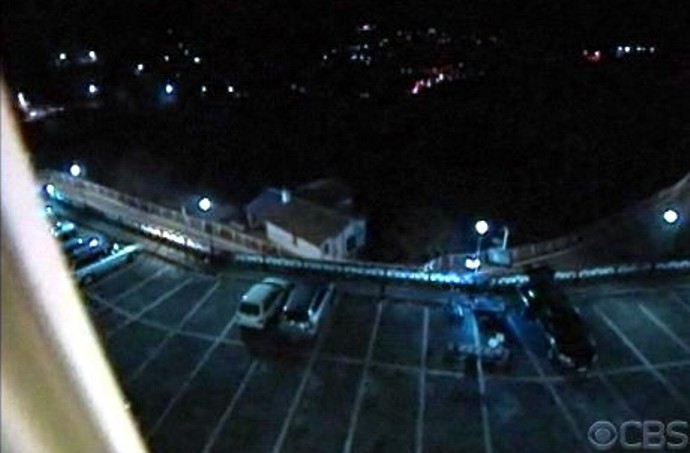
[View down on Meredith’s very well-lit house from the apartment above witness Madame Nara Capezzali’s]
Surreal Documentary Context
We have a very surreal situation on our hands. One perhaps without legal precedent. As previously in this series the legal document being analysed here is the Hellmann-Zanetti appeal report.
1) No main media in the US or UK have put that appeal report into English or done any serious legal analysis.
2) Nor have they translated the original trial report by Judge Massei or done any serious analysis of that.
3) Nor have they translated the tough and detailed appeal to the Supreme Court by the Chief Prosecutor of Umbria, Dr Galat, which was summarised and analysed by Yummi here. The meticulous PMF translation team should complete its translation soon.
4) None of the books on the case at present bring the legal developments up to the present or get into the details of the very tough Galati appeal.
Meanwhile the Knox and Sollecito teams are racing to get out their books in the US, with media interviews being scheduled, presumably in the hope that this vacuum of hard facts described above continues and they can fill it with their own kind of PR spin.
Of course none of this impinges on pending legal events in Italy where interested Italians have a radically different and more informed view. Except only to make sure everything is done correctly and firmly to the letter.
As usual, Knox and Sollecito are coming across as if they are on a different planet. Not one good lawyer seems to be explaining things to them, or even be of top of things for that matter.
On Hellmann-Zanetti on Time of Death
In this series, my previous posts explained the distortions and illogicalities in the Hellmann-Zanetti appeal report in the passages on the calunnia (false blaming of Patrick), witness Curatolo, and witness Quintavalle, and also the seeming prejudicial language used throughout.
Vital reading in advance of this post is Considering The Sad And Sensitive But Also Crucial Subject Of Meredith’s Time Of Death by my fellow lawyer James Raper.
He explained the difficulties of being precise about Meredith’s time of death, and he commented on Hellman-Zanetti as follows.
The first point to note here is that Hellmann misinterprets the first Court’s findings. He ignores the fact that the first Court did determine a TOD between 11pm and 11.30 pm as probable based on the pathology alone, and gave reasons for this.
None of the expert testimony is rehearsed, let alone re-evaluated by Hellmann. He proceeds merely to discredit the reliability of the witnesses as to the other elements such as the scream etc.
One recalls that Nara Capezzali says that she heard a scream sometime between 11 and 11.30 pm. That there was a broken down car and the breakdown driver came and went between perhaps 11 and 11.15 pm.
As mentioned earlier his hypothesizing about the other elements leads him to a TOD of not later than 10.13 pm although this time seems a very random one based on what he presents. He talks in this section about Guede’s statement that he arrived at the cottage at 9 pm.
One suspects that if Hellmann could have fixed the time of death at 9.15 pm or 9.30 pm then he would have done so as either time would be a get out of jail free card for Knox and Sollecito. He did not, but he got them out of jail nevertheless with his hypothesizing - here and elsewhere in his report.
So perhaps not surprisingly Dr Galati in his appeal to Cassation devotes nearly 3000 words to taking apart Hellmann-Zanetti’s arguments on Time of Death, under these 4 headings:
- Defect or manifest lack of logic in the sentencing report
- The intercepted chat [Guede on Skype]
- Meredith’s mobile phones
- The testimony of the three women [Capezzali, Monacchia, and Dramis]
Hellmann-Zanetti is politely but explicitly excoriated. In Dr Galati’s summarising of his own arguments he states this:
The claimed timing of the death of Meredith Kercher demonstrates a manifest illogicality in the reasoning, contains an unfounded assessment, and is manifestly in contrast with other court documentation of the case.
The internal and external inconsistencies of Hellmann’s statements on the topic constitute [yet another] violation of the Criminal Procedure Code.
Here are some examples of H/Z’s flood of reasons-to-doubt AK/RS’s guilt listed under Time of Death and not specifically mentioned in previous Dissections [my emphases]:
- Capezzalli “”¦was not able to pinpoint an exact time”¦”
- ”“¦the source of those [the scream and other] noises is not certain at all”¦.”
- ”“¦Monacchia’s testimony does not allow the time of the scream to be pinpointed at 11:30 PM, rather than at 11 PM or even before.”
- ”“¦she heard a loud scream of a woman, of which she could not however locate the source with certainty.”
- “The witness was not more accurate about the time, she could not connect it to objective data, but in her first testimony [verbale], when she presented herself to the investigators (the transcript of November 8, 2008 used for the indictment) she mentioned [aveva indicato] ʺ... at about 11 PMʺ. Monacchia’s statements therefore increase the ambiguity, as circumstantial evidence, of Capezzali’s statements instead of resolving it.”
- “Dramis, in fact, said that she went to sleep at around 11”11:30 PM, and that she woke up later (without being able, however, to specify how much later, while not excluding that it could have been 11:30 PM) due to the noise of quick footsteps, but she could not specify their direction, nor if they were produced by one or more persons, and she also noted that such events are not at all uncommon in this place”¦.. We find ourselves, therefore, confronting a piece of circumstantial evidence (scream and footsteps) [which is] extremely weak for its ambiguity, since it cannot even be placed with certainty in time.”
On Hellmann-Zanetti on Blameworthiness of Defendants.
As an example of a possible tendency under any legal system, Canadian law has already strayed-away on this subject, over a period of about nine years, and was only recently brought-back only by an Appellate ruling. So attempts to derail Italian law on this issue may be inevitable:
Canadian criminal law aims to maintain proportionality between the stigma and punishment attached to a conviction and the moral blameworthiness of an offender, in R v. Martineau (1990) the Supreme Court of Canada held that it is a principle of fundamental justice under sections 7 and 11(d) of the Canadian Charter of Rights and Freedoms that a conviction for murder requires proof beyond a reasonable doubt of a subjective foresight of death. In so doing, the court effectively declared sections 213 and 229(a)(i) and (ii) of the Criminal Code of Canada lacking in constitutional muster.[7]
Section 213(a) provided that a conviction for murder would lie for any killing that was “objectively foreseeable as a result of the abominable nature of the predicate crimes…inter alia…coupled with intentional infliction of bodily harm”.[7] . This largely equated with a Canadian form of felony murder, though it is technically closer to constructive murder in other jurisdictions.[8] .
Nevertheless s. 229(c), which provides for a form of constructive felony murder in situations where “an accused for an unlawful object did anything knowing that it was likely [on an objective standard] to cause someone’s death” is still operative, as confirmed in a 1999 appellate court decision”
Common-Law “˜Malice’ has historically required that an accused “knew, or ought to have known that the relevant act was wrong.”
In that “ought” lies an escape hatch.
What we believe as to the blameworthiness of these three offenders is obvious - they were committing a premeditated felony-sexual-assault using means which were foreseeably lethal, and actually were lethal.
Hellmann-Zanetti have already made clear what their blameworthiness opinion would be, although they have evaded reaching the issue by arguing reasonable doubt that two of the offenders were involved in Meredith’s murder, and deserve no blame for it whatsoever.
A legal issue which may eventually need to be addressed is whether a conviction for murder requires proof beyond a reasonable doubt using a subjective foreseeability of death standard or using an objective foreseeability of death standard.
If a subjective foresight of death were ever applied to a found-guilty AK & RS, they could plead that they just didn’t foresee that pricking Meredith’s neck with those knives could kill her; it was just a prank. For example “we were only hazing her; anyway, we were either mentally-ill or drugged or just plain dumb.”
If an objective foresight of death finding were ever applied to a found-guilty AK & RS, who were obviously committing a felonious assault using foreseeably lethal means, Meredith would get True Justice.

